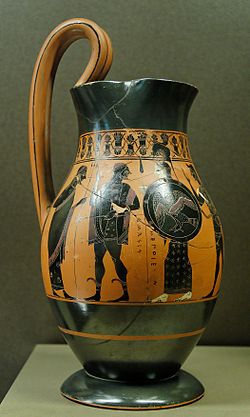Amasis Painter | |
|---|---|
 Heracles entering Mount Olympus, olpe by the Amasis Painter, dated to within 550–530 BC. Inscription: AMASIS MEΠOIESEN, Amasis m'epoiesen, "Amasis made (me)". Located in the Louvre Museum, Paris. | |
| Born | Amasis Before 550 BC Athens or Egypt |
| Died | About 510 BC |
| Nationality | Greek or Egyptian |
| Known for | Vase painting |
| Notable work | About 90 vase paintings |
| Movement | Black-figure style |
| Patron(s) | Possibly Solon, if he was from Egypt |

The Amasis Painter (active around 550–510 BC[1] in Athens) was an ancient Greek vase painter who worked in the black-figure technique. He owes his name to the signature of the potter Amasis ("Amasis made me"), who signed twelve works painted by the same hand.[2] At the time of the exhibition, "The Amasis Painter and His World" (1985), 132 vases had been attributed to this artist.[3]
- ^ "The Amasis Painter", The Journal of Hellenic Studies Vol. 78 (1958), pp. 1-3
- ^ J. D. Beazley, The Development of Attic Black-Figure, updated by Dietrich von Bothmer and Mary Moore (Berkeley: University of California Press, 1986), 52.
- ^ Dietrich von Bothmer, The Amasis Painter and His World: Vase-Painting in Sixth-Century B.C. Athens (New York and London: Thames and Hudson, and Malibu: J. Paul Getty Museum, 1985), 11.